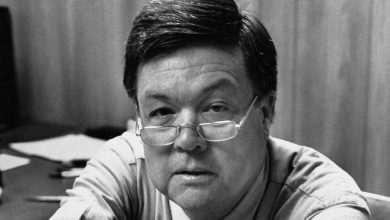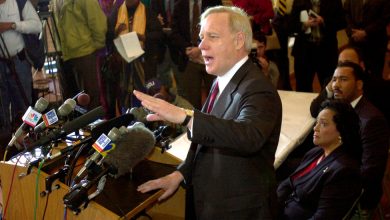Russian Forces Pound Civilians, as Putin Likens Sanctions to a ‘Declaration of War’

ODESSA, Ukraine — President Vladimir V. Putin warned on Saturday that crippling economic sanctions imposed by the West were “akin to a declaration of war,” as the Russian military pummeled civilian targets and continued shelling near the first protected routes intended to allow besieged Ukrainians to flee, apparently violating a cease-fire that had been agreed to only hours earlier.
The Russian attacks near the “humanitarian corridors,” reported by Ukrainian officials, came hours after both countries had agreed to open safe routes for residents to flee Mariupol, a major port city on the Sea of Azov where tens of thousands of people have been without heat, electricity or water for three days, and Volnovakha, another beleaguered town 40 miles to the north.
Ten days into the Russian invasion, the shelling around the corridors made clear that Mr. Putin had settled on a plan to hammer civilian infrastructure and pulverize basic services and neighborhoods in a sustained assault that has set off what the United Nations calls the fastest-moving exodus of European refugees since World War II.
In a news conference in the capital, Kyiv, the Ukrainian authorities presented a dozen stoned-faced Russian prisoners of war, who spoke of chaotic firefights that had led to their capture and condemned Russian leaders.
It was impossible to ascertain whether the soldiers were speaking under duress. The Geneva Convention prohibits militaries from parading prisoners.
Mr. Putin, in his first extended remarks since the start of the war, threatened to fully absorb Ukraine, the former Soviet republic of nearly 44 million people that declared its independence from Moscow 30 years ago.
“The current leadership needs to understand that if they continue doing what they are doing, they risk the future of Ukrainian statehood,” he said.
In addition to his warning on sanctions, which have been crushing Russia’s economy, Mr. Putin said that imposing a no-fly zone over Ukraine — which Ukrainian officials have been demanding, but NATO has so far rejected — “will be seen by us as participation in the armed conflict.” He blamed Ukraine for sabotaging the humanitarian routes, saying its troops had used civilians as “human shields.”
Mr. Putin’s threats came as residents in the first major city to fall to Russian troops, Kherson, in southern Ukraine, took to the streets to protest, chanting and waving Ukrainian flags. The demonstrations were the most visible example yet of resistance to Russian occupation and a direct rebuke to Mr. Putin’s claim that the Russian military has been liberating Ukrainian cities.
Around 10 a.m. hundreds of people started gathering in Liberty Square, in the center of Kherson, according to videos of the scene. In one video, a man stood atop a Russian armored personnel carrier, waving a Ukrainian flag as it drove down the street, prompting cheers from onlookers.
The city’s mayor, Ihor Kolykhaev, said Russian forces had fired into the air to disperse the crowd, though protesters initially stayed in the area. There were no reports of casualties, he said, estimating the crowd’s size at about 2,000 people.

The protests underscored the challenges facing the Russian military as its moves to capture and hold Ukrainian territory. Mr. Putin insists that Ukrainians and Russians are “one people,” and has described resistance to Russia’s incursion as the product of brainwashing by nefarious Western operators and “neo-Nazis” in the Kyiv government.
But Mr. Kolykhaev said it was ludicrous for Russian forces to destroy city services and supply lines for medicines and other essential goods and then present themselves as “kind liberators.” Russian troops seized Kherson on Wednesday after a vicious battle that killed 300 people, including dozens of civilians, he said.
“First they create a critical situation,” Mr. Kolykhaev said in a text message, “then heroically they save us.”
The Russian assault has also deepened the desperation in Mariupol, a major city of nearly half a million people in southern Ukraine where residents described children trapped in bomb shelters without food, water or warmth. It has been largely impossible to bring in medical supplies and other relief to the city, where the local government has refused to surrender, despite daily bombing by Russian forces, which have surrounded the city.
“The shelling is constant and at random,” Diana Berg, a Mariupol resident, said in an interview on Thursday. “Everything I ever thought to be a nightmare is nothing compared to what I am witnessing.”
Mariupol was cut off from telecommunications, she said, meaning there was no internet, cellphone service, electricity or hot water. Residents, she said, were building fires in the streets to stay warm. “And when you’re on the street, at any moment, a rocket can land next to you,” Ms. Berg said.
In an effort to alleviate the suffering, Russia’s Defense Ministry said on Saturday that it had agreed to a cease-fire and safe routes for residents of Mariupol and Volnovakha, a nearby city in equally dire straits, beginning at 10 a.m. Moscow time.
But Ukrainian officials said that Russian troops had quickly violated the agreement, and they warned residents who were planning to leave the cities to turn back and take shelter. “The Russian side is not upholding the cease-fire and is continuing to shell Mariupol and the surrounding regions,” Mariupol’s administration said on Saturday afternoon.
Since the war began, at least 1.2 million people in Ukraine have fled to neighboring countries, the head of the United Nations refugee agency said on Saturday. The movement, mostly of women and children, is coming at a faster rate than during the height of the Balkan wars in the 1990s and far faster than during the Hungarian refugee crisis of 1956, when Soviet troops crushed an uprising in that country, said Filippo Grandi, the U.N. High Commissioner for Refugees.
“This is the fastest-moving refugee crisis — let’s call it a refugee crisis, please, it’s a refugee crisis — since World War II,” Mr. Grandi said in an interview after returning from a visit to the border between Ukraine and Moldova.
He said he had been particularly struck by the jarring suddenness with which the refugees crossing there had been wrested from comfortable lives in what had until recently been calm, functional cities.
“It is an avalanche of people with cars, with pets,” Mr. Grandi said. “It’s entire cities being emptied, and crossing the border.”
Poland has taken in the largest number of Ukrainians, but Mr. Grandi was particularly concerned about Moldova, which has received more refugees per capita than any of Ukraine’s other neighbors. Since Feb. 24, more than 200,000 people coming from Ukraine have entered Moldova, which is home to 2.6 million and is one of Europe’s poorest countries.
Unlike its neighbors to the west, Moldova is not a member of the European Union, and therefore lacks significant institutional support from the bloc.
As the United States and its NATO allies have moved to resupply the outgunned and outmanned Ukrainian military with Javelin and Stinger missiles and other weapons, Western officials said the Russian offensive was encountering stubborn resistance.
Outside Kyiv, there have been fierce attacks and counterattacks as Ukrainian forces battled to keep the Russians from encircling the city. A 40-mile-long convoy of military vehicles approaching Kyiv from the north seems to be largely stalled, according to Western analysts, and the Ukrainian military said its forces have been attacking it where they can.
The news conference with Russian prisoners of war on Saturday was hastily organized by the Ukrainian authorities to bolster their claim that the Ukrainian military is successfully defending itself against Russian forces beset with logistical problems and low morale.
The Russian soldiers, reading from prepared statements and answering questions as masked and heavily armed security officials looked on, described being captured after their armored columns were ambushed.
“The whole column burned,” said one soldier, who identified himself as Lt. Dmitri Kovalensky. He said his tank unit was attacked by what he believed was a mix of projectiles from an armed drone and shoulder-fired anti-tank missiles near Sumy, in northeastern Ukraine. He said he ran into a forest and later surrendered.
There was one hint the captives were worried about their appearance at the news conference. “Now, after this press conference, I am afraid not only for myself but also for my family” back in Russia, Sgt. Mikhail Kulikov said.
In its latest assessment of the Russian assault, the British Ministry of Defense said Ukraine continued to hold three key cities — Kharkiv, Chernihiv and Mariupol — as well as Sumy, although it was “highly likely” that Russian forces had encircled all four.
Western analysts said Russia appeared to be advancing on the southern port city of Mykolaiv, where residents and the military have braced for an imminent attack. But those troops might bypass the city to speed their advance on Odessa, a major port on the Black Sea and the headquarters of the Ukrainian Navy.
Ukraine’s defense minister said on Saturday that his country’s forces and its cities were most vulnerable to air assault. “Aircraft of all kinds are bombing cities, towns and civilian infrastructure, including critical and dangerous nuclear and hydropower plants,” the minister, Oleksii Reznikov, said in a statement.
He said that Russian forces had hit residential neighborhoods, schools, hospitals and churches, and had shelled transportation hubs as people tried to flee.
The Russian forces’ primary objective is to encircle Kyiv, Mr. Reznikov said, and to weaken resistance in cities that Russian troops have surrounded or are pressing to capture.
Michael Schwirtz reported from Odessa, Ukraine; Andrew E. Kramer from Kyiv, Ukraine; and Michael Levenson from New York. Reporting was contributed by Marc Santora in Lviv, Ukraine; Patrick Kingsley in Chisinau, Moldova; and Masha Froliak in Kyiv.




